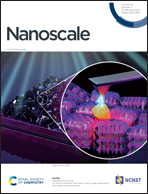Pressure-induced bandgap engineering and photoresponse enhancement of wurtzite CuInS2 nanocrystals†
Abstract
Wurtzite CuInS2 exhibits great potential for optoelectronic applications because of its excellent optical properties and good stability. However, exploring effective strategies to simultaneously optimize its optical and photoelectrical properties remains a challenge. In this study, the bandgap of wurtzite CuInS2 nanocrystals is successfully extended and the photocurrent is enhanced synchronously using external pressure. The bandgap of wurtzite CuInS2 increases with pressure and reaches an optimal value (1.5 eV) for photovoltaic solar energy conversion at about 5.9 GPa. Surprisingly, the photocurrent simultaneously increases nearly 3-fold and reaches the maximum value at this critical pressure. Theoretical calculation indicates that the pressure-induced bandgap extention in wurtzite CuInS2 may be attributed to an increased charge density and ionic polarization between the In–S atoms. The photocurrent preserves a relatively high photoresponse even at 8.8 GPa, but almost disappears above 10.3 GPa. The structural evolution demonstrates that CuInS2 undergoes a phase transformation from the wurtzite phase (P63mc) to the rock salt phase (Fm![[3 with combining macron]](https://www.rsc.org/images/entities/char_0033_0304.gif) m) at about 10.3 GPa, which resulted in a direct to indirect bandgap transition and fianlly caused a dramatic reduction in photocurrent. These results not only map a new route toward further increase in the photoelectrical performance of wurtzite CuInS2, but also advance the current research of AI–BIII–CVI2 materials.
m) at about 10.3 GPa, which resulted in a direct to indirect bandgap transition and fianlly caused a dramatic reduction in photocurrent. These results not only map a new route toward further increase in the photoelectrical performance of wurtzite CuInS2, but also advance the current research of AI–BIII–CVI2 materials.



 Please wait while we load your content...
Please wait while we load your content...